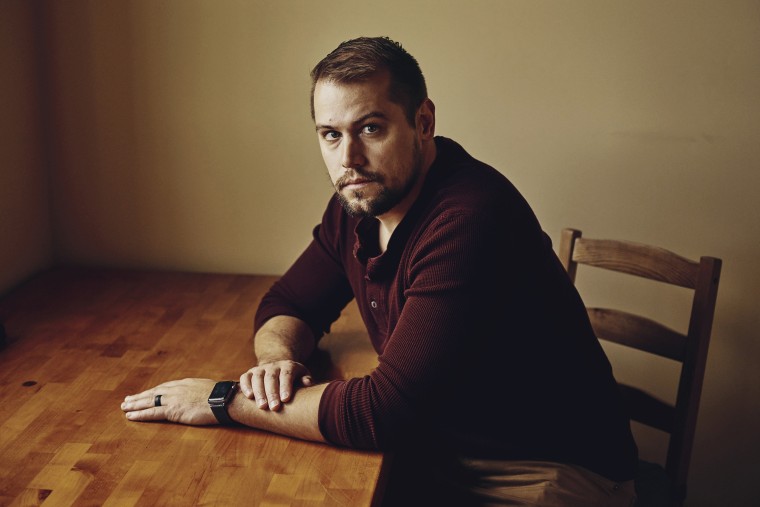The first active-duty military pilot to come forward to Congress about his experience with so-called unexplained aerial phenomena is starting a first-of-its-kind nonprofit group to support other pilots who see things they can’t explain, he said.
Airline passengers are encouraged to report suspicious activity in the name of national security, but the pilots on those same planes often face professional stigma and institutional obstacles in reporting unexplained aerial phenomena, or UAPs, that could represent national security threats in the age of drones and spy balloons, advocates say.
For instance, the Federal Aviation Administration has no mechanism for pilots to report UAPs, the term preferred to UFOs, instead directing them to civilian UFO groups that are often dismissed as the domain of cranks and conspiracy theorists.
Americans for Safe Aerospace, which is officially launching Thursday as the first pilot-led advocacy organization dedicated to UAPs, seeks to change that. Co-founded and run by former Navy fighter pilot Ryan Graves, the group, which provided exclusive details to NBC News, aims to better support aviators who witness unexplained events.
The group wants to push for policy changes, like better reporting mechanisms, serve as a hub for pilot whistleblowers and advocate for more disclosure by the military and other government agencies.
“Unidentified objects in our airspace present an urgent and critical safety and national security issue, but pilots are not getting the support they need and the respect they deserve,” Graves said. “When I served, my squadron was encountering UAP nearly every day, and nothing was being done.”

Five other former military aviators, in addition to a commercial pilot and flight instructor, have joined the group’s Aircrew Council, and its Advisory Board includes prominent civilian researchers like Harvard astronomer Avi Loeb; politicos like Susan McCue, the longtime chief of staff to the late Senate Democratic leader Harry Reid; astronaut Terry Virts, the former commander of the International Space Station; and a former head of the National Oceanic and Atmospheric Administration, retired Navy Rear Adm. Tim Gallaudet.
UAPs are often conflated with aliens in the popular imagination, but earthly mysteries may be more pressing — from the undeclared drone attacks on Moscow apartment buildings this week to the recent flight of a Chinese spy balloon over sensitive U.S. military installations, which advocates say traditional U.S. aerospace defenses aren’t calibrated to detect.
U.S. fighter jets shot down two other unidentified objects, which many people now suspect were hobbyist balloons, over North American airspace in the days after the U.S. military knocked out the Chinese balloon, but the confusion and lack of information about what’s happening over the U.S. is dangerous for pilots and passengers, Graves and others say.
“The establishment of Americans for Safe Aerospace is long overdue,” Gallaudet said in a statement. “As the chief meteorologist for the U.S. Navy, I dedicated my career to the safety of flight. I have seen firsthand how Unidentified Anomalous Phenomena (UAP) have placed military pilots at risk, and we need to better understand them to reduce that risk.”
Washington has begun to take UAPs more seriously. The Defense Department and U.S. intelligence agencies have started releasing more information. And this week NASA held the first public meeting of its new committee tasked with studying UAPs, which said the stigma around reporting strange sightings has contributed to a lack of good data.
“One of our goals in having NASA play a role is to remove stigma and get high-quality data,” David Spergel, a prominent Princeton University astrophysicist who chairs the NASA panel, said at the meeting Wednesday.
Graves said that most pilots he knows either have seen something they can't explain or know someone who has but that until recently, most would talk about it only in hushed tones and in private settings for fear of being mocked or jeopardizing their career growth.
Most of the sightings are probably innocuous, Graves said, citing analyses that were able to explain away all but 2% to 5% of anomalous sightings, but that still represents dozens of sightings of potential new threats from China, Russia — or somewhere else.
And the rapid proliferation of drones of all shapes and sizes has compounded the problem.
“As our airspace gets more congested and more critical to our daily lives, we need to have a better understanding of what is in our sky for the safety of our pilots and the general public,” said David Radzanowski, NASA’s former chief financial officer and chief of staff, who is on the group’s advisory board.
Graves said he's already in conversation with pilots interested in going public with potentially important UAP sightings with multiple witnesses, and he said more is likely to be out there.
"It's pretty simple," he said. “We should know what’s up there, over our heads.”

